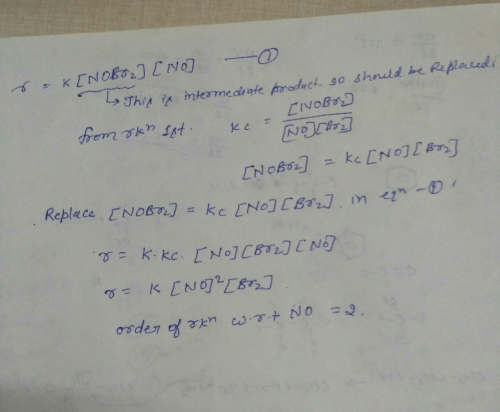Class 12 Exam > Class 12 Questions > The following mechanism has been proposed for...
Start Learning for Free
The following mechanism has been proposed for thereaction of NO with Br2 to form NOBr.
If the second step is the rate determining step, the order of the reaction with respect to NO(g) is
- a)1
- b)0
- c)3
- d)2
Correct answer is option 'D'. Can you explain this answer?
| FREE This question is part of | Download PDF Attempt this Test |
Most Upvoted Answer
The following mechanism has been proposed for thereaction of NO with B...


|
Explore Courses for Class 12 exam
|

|
Similar Class 12 Doubts
The following mechanism has been proposed for thereaction of NO with Br2 to form NOBr.If the second step is the rate determining step, the order of the reaction with respect to NO(g) isa)1b)0c)3d)2Correct answer is option 'D'. Can you explain this answer?
Question Description
The following mechanism has been proposed for thereaction of NO with Br2 to form NOBr.If the second step is the rate determining step, the order of the reaction with respect to NO(g) isa)1b)0c)3d)2Correct answer is option 'D'. Can you explain this answer? for Class 12 2024 is part of Class 12 preparation. The Question and answers have been prepared according to the Class 12 exam syllabus. Information about The following mechanism has been proposed for thereaction of NO with Br2 to form NOBr.If the second step is the rate determining step, the order of the reaction with respect to NO(g) isa)1b)0c)3d)2Correct answer is option 'D'. Can you explain this answer? covers all topics & solutions for Class 12 2024 Exam. Find important definitions, questions, meanings, examples, exercises and tests below for The following mechanism has been proposed for thereaction of NO with Br2 to form NOBr.If the second step is the rate determining step, the order of the reaction with respect to NO(g) isa)1b)0c)3d)2Correct answer is option 'D'. Can you explain this answer?.
The following mechanism has been proposed for thereaction of NO with Br2 to form NOBr.If the second step is the rate determining step, the order of the reaction with respect to NO(g) isa)1b)0c)3d)2Correct answer is option 'D'. Can you explain this answer? for Class 12 2024 is part of Class 12 preparation. The Question and answers have been prepared according to the Class 12 exam syllabus. Information about The following mechanism has been proposed for thereaction of NO with Br2 to form NOBr.If the second step is the rate determining step, the order of the reaction with respect to NO(g) isa)1b)0c)3d)2Correct answer is option 'D'. Can you explain this answer? covers all topics & solutions for Class 12 2024 Exam. Find important definitions, questions, meanings, examples, exercises and tests below for The following mechanism has been proposed for thereaction of NO with Br2 to form NOBr.If the second step is the rate determining step, the order of the reaction with respect to NO(g) isa)1b)0c)3d)2Correct answer is option 'D'. Can you explain this answer?.
Solutions for The following mechanism has been proposed for thereaction of NO with Br2 to form NOBr.If the second step is the rate determining step, the order of the reaction with respect to NO(g) isa)1b)0c)3d)2Correct answer is option 'D'. Can you explain this answer? in English & in Hindi are available as part of our courses for Class 12.
Download more important topics, notes, lectures and mock test series for Class 12 Exam by signing up for free.
Here you can find the meaning of The following mechanism has been proposed for thereaction of NO with Br2 to form NOBr.If the second step is the rate determining step, the order of the reaction with respect to NO(g) isa)1b)0c)3d)2Correct answer is option 'D'. Can you explain this answer? defined & explained in the simplest way possible. Besides giving the explanation of
The following mechanism has been proposed for thereaction of NO with Br2 to form NOBr.If the second step is the rate determining step, the order of the reaction with respect to NO(g) isa)1b)0c)3d)2Correct answer is option 'D'. Can you explain this answer?, a detailed solution for The following mechanism has been proposed for thereaction of NO with Br2 to form NOBr.If the second step is the rate determining step, the order of the reaction with respect to NO(g) isa)1b)0c)3d)2Correct answer is option 'D'. Can you explain this answer? has been provided alongside types of The following mechanism has been proposed for thereaction of NO with Br2 to form NOBr.If the second step is the rate determining step, the order of the reaction with respect to NO(g) isa)1b)0c)3d)2Correct answer is option 'D'. Can you explain this answer? theory, EduRev gives you an
ample number of questions to practice The following mechanism has been proposed for thereaction of NO with Br2 to form NOBr.If the second step is the rate determining step, the order of the reaction with respect to NO(g) isa)1b)0c)3d)2Correct answer is option 'D'. Can you explain this answer? tests, examples and also practice Class 12 tests.

|
Explore Courses for Class 12 exam
|

|
Signup for Free!
Signup to see your scores go up within 7 days! Learn & Practice with 1000+ FREE Notes, Videos & Tests.


















